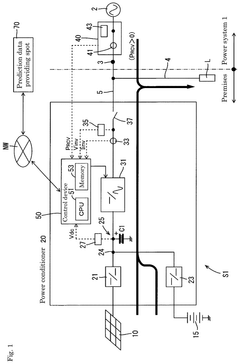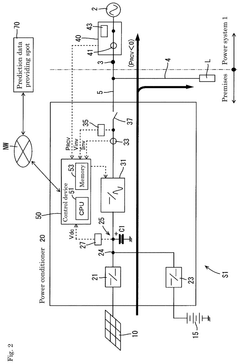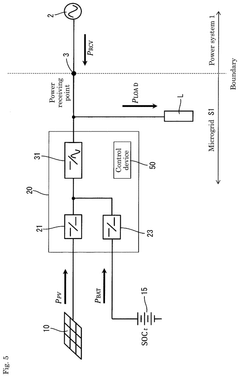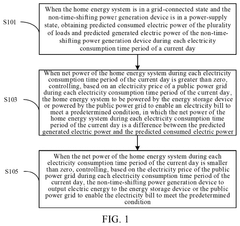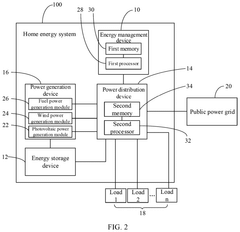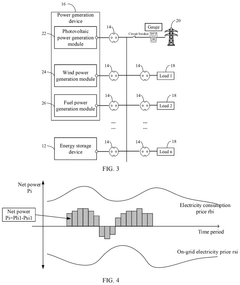How to Enhance Home Energy Management with Solar Inverters?
JUL 17, 20259 MIN READ
Generate Your Research Report Instantly with AI Agent
Patsnap Eureka helps you evaluate technical feasibility & market potential.
Solar Inverter Evolution and Objectives
Solar inverters have undergone significant evolution since their inception, transforming from simple power conversion devices to sophisticated energy management systems. The journey began in the 1990s with basic grid-tied inverters, primarily focused on converting DC power from solar panels to AC power for home use. These early models lacked advanced features and had limited efficiency.
As solar technology gained traction in the early 2000s, inverter manufacturers started incorporating maximum power point tracking (MPPT) algorithms, dramatically improving energy harvest from solar panels. This innovation marked a crucial step in enhancing the overall efficiency of solar energy systems, allowing for better utilization of available sunlight.
The next major leap came with the introduction of smart inverters in the late 2000s. These devices integrated communication capabilities, enabling remote monitoring and control. This advancement paved the way for more sophisticated energy management, allowing homeowners and utilities to optimize power flow and respond to grid conditions in real-time.
In recent years, the focus has shifted towards developing hybrid inverters that can seamlessly integrate with battery storage systems. This integration is crucial for maximizing self-consumption of solar energy and providing backup power during grid outages. The latest inverters also incorporate advanced grid support functions, contributing to grid stability and enabling higher penetration of renewable energy sources.
Looking ahead, the objectives for solar inverter technology are multifaceted. One primary goal is to further increase efficiency, with manufacturers aiming to push conversion rates beyond 99%. This improvement would translate to significant energy savings over the lifetime of solar installations.
Another key objective is enhancing the role of inverters in home energy management systems. Future inverters are expected to act as central hubs, orchestrating power flow between solar panels, battery storage, electric vehicle charging, and various household appliances. This integration aims to optimize energy usage, reduce reliance on the grid, and lower electricity costs for homeowners.
Improving grid resilience is also a critical objective. Advanced inverters are being developed to provide ancillary services to the grid, such as voltage regulation and frequency support. These capabilities will become increasingly important as the penetration of distributed energy resources grows, helping to maintain grid stability in a renewable-dominated energy landscape.
Lastly, there is a strong focus on enhancing the intelligence and connectivity of inverters. The integration of artificial intelligence and machine learning algorithms is expected to enable predictive maintenance, optimize energy flows based on usage patterns and weather forecasts, and facilitate seamless integration with smart home ecosystems.
As solar technology gained traction in the early 2000s, inverter manufacturers started incorporating maximum power point tracking (MPPT) algorithms, dramatically improving energy harvest from solar panels. This innovation marked a crucial step in enhancing the overall efficiency of solar energy systems, allowing for better utilization of available sunlight.
The next major leap came with the introduction of smart inverters in the late 2000s. These devices integrated communication capabilities, enabling remote monitoring and control. This advancement paved the way for more sophisticated energy management, allowing homeowners and utilities to optimize power flow and respond to grid conditions in real-time.
In recent years, the focus has shifted towards developing hybrid inverters that can seamlessly integrate with battery storage systems. This integration is crucial for maximizing self-consumption of solar energy and providing backup power during grid outages. The latest inverters also incorporate advanced grid support functions, contributing to grid stability and enabling higher penetration of renewable energy sources.
Looking ahead, the objectives for solar inverter technology are multifaceted. One primary goal is to further increase efficiency, with manufacturers aiming to push conversion rates beyond 99%. This improvement would translate to significant energy savings over the lifetime of solar installations.
Another key objective is enhancing the role of inverters in home energy management systems. Future inverters are expected to act as central hubs, orchestrating power flow between solar panels, battery storage, electric vehicle charging, and various household appliances. This integration aims to optimize energy usage, reduce reliance on the grid, and lower electricity costs for homeowners.
Improving grid resilience is also a critical objective. Advanced inverters are being developed to provide ancillary services to the grid, such as voltage regulation and frequency support. These capabilities will become increasingly important as the penetration of distributed energy resources grows, helping to maintain grid stability in a renewable-dominated energy landscape.
Lastly, there is a strong focus on enhancing the intelligence and connectivity of inverters. The integration of artificial intelligence and machine learning algorithms is expected to enable predictive maintenance, optimize energy flows based on usage patterns and weather forecasts, and facilitate seamless integration with smart home ecosystems.
Home Energy Management Market Analysis
The home energy management market has experienced significant growth in recent years, driven by increasing energy costs, environmental concerns, and the growing adoption of smart home technologies. This market segment focuses on solutions that enable homeowners to monitor, control, and optimize their energy consumption, with solar inverters playing a crucial role in integrating renewable energy sources into residential power systems.
Market research indicates that the global home energy management market is expected to continue its upward trajectory, with a compound annual growth rate (CAGR) projected to exceed 15% over the next five years. This growth is attributed to several factors, including government initiatives promoting energy efficiency, rising awareness of carbon footprint reduction, and the increasing affordability of smart home devices.
The integration of solar inverters into home energy management systems represents a key trend in this market. Solar inverters not only convert DC power from solar panels into AC power for home use but also serve as intelligent energy management devices. They can optimize energy flow between solar generation, battery storage, and grid consumption, maximizing self-consumption of solar energy and reducing reliance on the grid.
Consumer demand for home energy management solutions is primarily driven by the desire to reduce electricity bills and increase energy independence. Homeowners are increasingly seeking ways to leverage their solar investments beyond simple grid feed-in, looking for solutions that allow them to store excess energy and use it during peak demand periods or grid outages.
The market landscape is characterized by a mix of established players in the energy sector and innovative startups. Major electronics manufacturers, utility companies, and solar equipment providers are expanding their offerings to include comprehensive home energy management solutions. Startups are focusing on developing advanced algorithms and user-friendly interfaces to differentiate their products in this competitive market.
Geographically, North America and Europe lead in market share, owing to high energy costs, supportive regulatory environments, and greater consumer awareness. However, the Asia-Pacific region is expected to witness the fastest growth, driven by rapid urbanization, increasing disposable incomes, and government initiatives promoting clean energy adoption.
Challenges in the market include interoperability issues between different smart home devices, concerns about data privacy and security, and the need for significant upfront investments. However, these challenges are being addressed through industry standardization efforts, enhanced cybersecurity measures, and innovative financing models such as leasing and power purchase agreements.
Market research indicates that the global home energy management market is expected to continue its upward trajectory, with a compound annual growth rate (CAGR) projected to exceed 15% over the next five years. This growth is attributed to several factors, including government initiatives promoting energy efficiency, rising awareness of carbon footprint reduction, and the increasing affordability of smart home devices.
The integration of solar inverters into home energy management systems represents a key trend in this market. Solar inverters not only convert DC power from solar panels into AC power for home use but also serve as intelligent energy management devices. They can optimize energy flow between solar generation, battery storage, and grid consumption, maximizing self-consumption of solar energy and reducing reliance on the grid.
Consumer demand for home energy management solutions is primarily driven by the desire to reduce electricity bills and increase energy independence. Homeowners are increasingly seeking ways to leverage their solar investments beyond simple grid feed-in, looking for solutions that allow them to store excess energy and use it during peak demand periods or grid outages.
The market landscape is characterized by a mix of established players in the energy sector and innovative startups. Major electronics manufacturers, utility companies, and solar equipment providers are expanding their offerings to include comprehensive home energy management solutions. Startups are focusing on developing advanced algorithms and user-friendly interfaces to differentiate their products in this competitive market.
Geographically, North America and Europe lead in market share, owing to high energy costs, supportive regulatory environments, and greater consumer awareness. However, the Asia-Pacific region is expected to witness the fastest growth, driven by rapid urbanization, increasing disposable incomes, and government initiatives promoting clean energy adoption.
Challenges in the market include interoperability issues between different smart home devices, concerns about data privacy and security, and the need for significant upfront investments. However, these challenges are being addressed through industry standardization efforts, enhanced cybersecurity measures, and innovative financing models such as leasing and power purchase agreements.
Solar Inverter Technology Challenges
Solar inverter technology, while advancing rapidly, still faces several significant challenges that hinder its widespread adoption and optimal performance in home energy management systems. One of the primary issues is the efficiency of power conversion. Despite improvements, current solar inverters still experience energy losses during the DC to AC conversion process, reducing the overall system efficiency.
Another critical challenge is the integration of solar inverters with smart home systems and the broader power grid. Many existing inverters lack advanced communication capabilities, making it difficult to seamlessly incorporate them into comprehensive energy management solutions. This limitation hampers the ability to optimize energy usage and respond dynamically to changing grid conditions or household energy demands.
Reliability and durability remain ongoing concerns for solar inverter technology. Inverters are exposed to various environmental stresses, including temperature fluctuations, humidity, and electrical surges. Improving the robustness of these devices to withstand such conditions over extended periods is crucial for ensuring long-term performance and reducing maintenance costs.
The variability of solar power generation poses another significant challenge for inverter technology. Rapid changes in solar irradiance due to cloud cover or other environmental factors can lead to fluctuations in power output. Developing inverters capable of quickly adapting to these changes while maintaining stable power quality is essential for grid stability and efficient energy management.
Size and cost considerations also present obstacles to widespread adoption. While inverter technology has become more compact and affordable, there is still a need for further miniaturization and cost reduction to make solar energy systems more accessible to a broader range of homeowners.
Additionally, the complexity of installation and configuration remains a barrier. Many current inverter systems require professional installation and setup, which can be time-consuming and expensive. Simplifying the installation process and developing more user-friendly interfaces could significantly enhance the appeal of solar energy systems for home use.
Lastly, the challenge of energy storage integration is becoming increasingly important. As battery technology advances, there is a growing need for inverters that can efficiently manage bidirectional power flow between solar panels, batteries, and the grid. Developing inverters with sophisticated energy storage management capabilities is crucial for maximizing the benefits of solar energy in home settings.
Another critical challenge is the integration of solar inverters with smart home systems and the broader power grid. Many existing inverters lack advanced communication capabilities, making it difficult to seamlessly incorporate them into comprehensive energy management solutions. This limitation hampers the ability to optimize energy usage and respond dynamically to changing grid conditions or household energy demands.
Reliability and durability remain ongoing concerns for solar inverter technology. Inverters are exposed to various environmental stresses, including temperature fluctuations, humidity, and electrical surges. Improving the robustness of these devices to withstand such conditions over extended periods is crucial for ensuring long-term performance and reducing maintenance costs.
The variability of solar power generation poses another significant challenge for inverter technology. Rapid changes in solar irradiance due to cloud cover or other environmental factors can lead to fluctuations in power output. Developing inverters capable of quickly adapting to these changes while maintaining stable power quality is essential for grid stability and efficient energy management.
Size and cost considerations also present obstacles to widespread adoption. While inverter technology has become more compact and affordable, there is still a need for further miniaturization and cost reduction to make solar energy systems more accessible to a broader range of homeowners.
Additionally, the complexity of installation and configuration remains a barrier. Many current inverter systems require professional installation and setup, which can be time-consuming and expensive. Simplifying the installation process and developing more user-friendly interfaces could significantly enhance the appeal of solar energy systems for home use.
Lastly, the challenge of energy storage integration is becoming increasingly important. As battery technology advances, there is a growing need for inverters that can efficiently manage bidirectional power flow between solar panels, batteries, and the grid. Developing inverters with sophisticated energy storage management capabilities is crucial for maximizing the benefits of solar energy in home settings.
Current Home Energy Management Solutions
01 Solar inverter efficiency optimization
Techniques for improving the efficiency of solar inverters, including advanced power conversion algorithms, thermal management systems, and intelligent control mechanisms. These optimizations help maximize energy output from solar panels and reduce conversion losses.- Solar inverter power management systems: Advanced power management systems for solar inverters that optimize energy conversion, distribution, and storage. These systems incorporate intelligent algorithms to balance power input from solar panels with grid demand and battery storage capabilities, maximizing overall system efficiency and reliability.
- Grid-tied solar inverter control strategies: Innovative control strategies for grid-connected solar inverters that enhance power quality, grid stability, and energy utilization. These methods include reactive power compensation, voltage regulation, and frequency support to improve overall grid performance while maximizing solar energy integration.
- Energy storage integration with solar inverters: Integration of energy storage systems with solar inverters to provide enhanced energy management capabilities. This approach allows for better load balancing, peak shaving, and increased self-consumption of solar-generated electricity, improving overall system economics and reliability.
- Smart monitoring and diagnostics for solar inverters: Advanced monitoring and diagnostic systems for solar inverters that utilize real-time data analysis, machine learning, and predictive maintenance techniques. These systems enhance inverter performance, reduce downtime, and optimize energy production through early fault detection and proactive maintenance scheduling.
- Multi-inverter coordination and load management: Sophisticated coordination and load management techniques for multi-inverter solar systems. These methods optimize power distribution across multiple inverters, manage varying loads, and ensure seamless operation in both grid-connected and islanded modes, improving overall system reliability and efficiency.
02 Grid integration and power management
Methods for seamlessly integrating solar inverters with the power grid, including smart grid communication protocols, load balancing techniques, and reactive power control. These features enable better coordination between solar energy systems and the utility grid.Expand Specific Solutions03 Energy storage and management systems
Integration of energy storage solutions with solar inverters, including battery management systems, charge controllers, and intelligent energy dispatch algorithms. These systems optimize energy utilization and provide backup power during grid outages.Expand Specific Solutions04 Monitoring and diagnostics
Advanced monitoring and diagnostic features for solar inverters, including real-time performance tracking, fault detection algorithms, and remote management capabilities. These tools help improve system reliability and facilitate preventive maintenance.Expand Specific Solutions05 Modular and scalable inverter designs
Innovative approaches to solar inverter design, focusing on modularity and scalability. These designs allow for easier installation, maintenance, and system expansion, catering to a wide range of solar energy applications from residential to utility-scale installations.Expand Specific Solutions
Key Solar Inverter Manufacturers
The home energy management market with solar inverters is in a growth phase, driven by increasing adoption of renewable energy and smart home technologies. The market size is expanding rapidly, with projections indicating significant growth in the coming years. Technologically, solar inverters are evolving from basic power conversion devices to sophisticated energy management systems. Companies like Tesla, Huawei Digital Power, and Enphase Energy are at the forefront, integrating advanced features such as AI-driven optimization, cloud connectivity, and seamless grid integration. Established players like Bosch and Midea are also entering this space, leveraging their expertise in home appliances and IoT. The competition is intensifying as companies strive to develop more efficient, intelligent, and user-friendly solutions for home energy management.
Tesla, Inc.
Technical Solution: Tesla's Powerwall and Solar Inverter system offers an integrated approach to home energy management. The Powerwall battery stores excess solar energy for use during peak hours or grid outages. Tesla's inverter technology boasts 97.5% efficiency and supports both on-grid and off-grid operations[3]. The system uses predictive algorithms to optimize energy flow based on weather forecasts, electricity rates, and historical usage patterns. Tesla's mobile app provides real-time energy monitoring and control, allowing users to manually or automatically switch between energy sources. The company's Virtual Power Plant (VPP) initiative aggregates multiple Powerwall systems to create a distributed energy resource, potentially offering grid services and additional revenue for homeowners[4].
Strengths: Seamless integration with Tesla ecosystem, high efficiency, VPP capabilities. Weaknesses: Higher initial cost, potential lock-in to Tesla's ecosystem.
Huawei Digital Power Technologies Co Ltd
Technical Solution: Huawei's smart energy management solution integrates solar inverters with AI-powered optimization algorithms. Their FusionSolar residential solution uses machine learning to predict energy generation and consumption patterns, dynamically adjusting power flow between solar panels, batteries, and the grid. The system employs advanced power electronics to achieve up to 98.6% conversion efficiency[1], maximizing energy harvest. Huawei's inverters feature built-in monitoring and diagnostics, allowing for real-time performance tracking and predictive maintenance. The company has also developed a cloud-based energy management platform that enables homeowners to monitor and control their energy usage via smartphone apps, promoting energy-conscious behavior[2].
Strengths: High efficiency, AI-driven optimization, comprehensive monitoring. Weaknesses: Potential cybersecurity concerns, reliance on cloud connectivity for advanced features.
Advanced Inverter Control Algorithms
Energy management device and energy management method
PatentPendingUS20240405549A1
Innovation
- An energy management device that calculates a target value for received power in a microgrid based on supply and demand predictions, using objective functions that evaluate energy storage usage and electricity rates, with constraints on power limits to optimize energy efficiency and reduce arithmetic calculations, thereby minimizing the influence on the power system and maintaining electricity quality.
Control method for home energy system, system, energy management device, and storage medium
PatentPendingUS20250045845A1
Innovation
- A control method for a home energy system that includes a power distribution device, a non-time-shifting power generation device, and an energy storage device. The method predicts consumed and generated electric power, and based on the net power and electricity prices, it controls the system to optimize power supply and consumption, ensuring the electricity bill meets a predetermined condition.
Regulatory Framework for Smart Grids
The regulatory framework for smart grids plays a crucial role in shaping the integration of solar inverters into home energy management systems. As governments worldwide recognize the importance of renewable energy and grid modernization, they are developing comprehensive policies and regulations to support the adoption of smart grid technologies.
At the national level, many countries have established energy policies that prioritize the development of smart grids and distributed energy resources. These policies often include targets for renewable energy integration, energy efficiency improvements, and grid reliability enhancements. For instance, the European Union's Clean Energy Package sets ambitious goals for smart meter deployment and consumer empowerment in energy management.
Regulatory bodies are implementing standards and guidelines to ensure the interoperability and security of smart grid components, including solar inverters. These standards address issues such as communication protocols, data exchange formats, and cybersecurity requirements. The IEEE 1547 standard, for example, provides guidelines for the interconnection of distributed energy resources with electric power systems.
To encourage the adoption of smart grid technologies, many jurisdictions have introduced incentive programs and regulatory mechanisms. Feed-in tariffs, net metering policies, and time-of-use pricing schemes are examples of regulatory tools that can motivate homeowners to invest in solar inverters and participate in energy management programs.
Grid codes and interconnection requirements are being updated to accommodate the increasing penetration of distributed energy resources. These regulations specify the technical requirements for solar inverters to connect to the grid, including power quality standards, voltage regulation capabilities, and fault ride-through performance.
Data privacy and security regulations are also evolving to address the concerns associated with smart grid technologies. These regulations aim to protect consumer information while enabling the necessary data exchange for effective energy management. The General Data Protection Regulation (GDPR) in Europe and similar laws in other regions provide frameworks for handling personal data in smart grid applications.
As the regulatory landscape continues to evolve, policymakers are exploring innovative approaches to support the integration of solar inverters in home energy management. This includes regulatory sandboxes that allow for controlled testing of new technologies and business models, as well as performance-based regulation that incentivizes utilities to improve grid efficiency and reliability through advanced technologies.
At the national level, many countries have established energy policies that prioritize the development of smart grids and distributed energy resources. These policies often include targets for renewable energy integration, energy efficiency improvements, and grid reliability enhancements. For instance, the European Union's Clean Energy Package sets ambitious goals for smart meter deployment and consumer empowerment in energy management.
Regulatory bodies are implementing standards and guidelines to ensure the interoperability and security of smart grid components, including solar inverters. These standards address issues such as communication protocols, data exchange formats, and cybersecurity requirements. The IEEE 1547 standard, for example, provides guidelines for the interconnection of distributed energy resources with electric power systems.
To encourage the adoption of smart grid technologies, many jurisdictions have introduced incentive programs and regulatory mechanisms. Feed-in tariffs, net metering policies, and time-of-use pricing schemes are examples of regulatory tools that can motivate homeowners to invest in solar inverters and participate in energy management programs.
Grid codes and interconnection requirements are being updated to accommodate the increasing penetration of distributed energy resources. These regulations specify the technical requirements for solar inverters to connect to the grid, including power quality standards, voltage regulation capabilities, and fault ride-through performance.
Data privacy and security regulations are also evolving to address the concerns associated with smart grid technologies. These regulations aim to protect consumer information while enabling the necessary data exchange for effective energy management. The General Data Protection Regulation (GDPR) in Europe and similar laws in other regions provide frameworks for handling personal data in smart grid applications.
As the regulatory landscape continues to evolve, policymakers are exploring innovative approaches to support the integration of solar inverters in home energy management. This includes regulatory sandboxes that allow for controlled testing of new technologies and business models, as well as performance-based regulation that incentivizes utilities to improve grid efficiency and reliability through advanced technologies.
Cybersecurity in Home Energy Systems
As home energy management systems become increasingly sophisticated, integrating solar inverters and other smart devices, the importance of robust cybersecurity measures cannot be overstated. The interconnected nature of these systems presents new vulnerabilities that malicious actors could exploit, potentially compromising not only individual households but also the broader power grid.
One of the primary concerns in home energy systems is the protection of sensitive data. Solar inverters and smart meters collect and transmit detailed information about energy consumption patterns, which could be used to infer occupancy and lifestyle habits if intercepted. Implementing strong encryption protocols for data transmission and storage is crucial to safeguard this information from unauthorized access.
Another critical aspect of cybersecurity in home energy systems is the prevention of unauthorized control. Solar inverters, being connected to the internet for remote monitoring and management, could be targeted by hackers seeking to disrupt power generation or manipulate energy flow. Robust authentication mechanisms, including multi-factor authentication and regular security updates, are essential to mitigate these risks.
The potential for cascading effects in interconnected systems also necessitates the implementation of isolation and containment strategies. In the event of a breach, it is vital to have measures in place to prevent the compromise of one device from spreading to others within the home energy network or beyond to the wider grid.
Regulatory compliance is an evolving challenge in this domain. As governments and industry bodies recognize the growing importance of cybersecurity in home energy systems, new standards and regulations are being developed. Staying abreast of these requirements and ensuring compliance is crucial for both manufacturers and homeowners.
Education and awareness play a significant role in maintaining the security of home energy systems. Homeowners must be informed about best practices for password management, software updates, and recognizing potential security threats. Regular security audits and vulnerability assessments should be conducted to identify and address potential weaknesses in the system.
As the technology continues to advance, emerging threats such as AI-powered attacks and quantum computing pose new challenges to cybersecurity in home energy systems. Ongoing research and development in areas like quantum-resistant encryption and adaptive security measures will be crucial to stay ahead of these evolving threats and ensure the long-term security and reliability of home energy management systems integrated with solar inverters.
One of the primary concerns in home energy systems is the protection of sensitive data. Solar inverters and smart meters collect and transmit detailed information about energy consumption patterns, which could be used to infer occupancy and lifestyle habits if intercepted. Implementing strong encryption protocols for data transmission and storage is crucial to safeguard this information from unauthorized access.
Another critical aspect of cybersecurity in home energy systems is the prevention of unauthorized control. Solar inverters, being connected to the internet for remote monitoring and management, could be targeted by hackers seeking to disrupt power generation or manipulate energy flow. Robust authentication mechanisms, including multi-factor authentication and regular security updates, are essential to mitigate these risks.
The potential for cascading effects in interconnected systems also necessitates the implementation of isolation and containment strategies. In the event of a breach, it is vital to have measures in place to prevent the compromise of one device from spreading to others within the home energy network or beyond to the wider grid.
Regulatory compliance is an evolving challenge in this domain. As governments and industry bodies recognize the growing importance of cybersecurity in home energy systems, new standards and regulations are being developed. Staying abreast of these requirements and ensuring compliance is crucial for both manufacturers and homeowners.
Education and awareness play a significant role in maintaining the security of home energy systems. Homeowners must be informed about best practices for password management, software updates, and recognizing potential security threats. Regular security audits and vulnerability assessments should be conducted to identify and address potential weaknesses in the system.
As the technology continues to advance, emerging threats such as AI-powered attacks and quantum computing pose new challenges to cybersecurity in home energy systems. Ongoing research and development in areas like quantum-resistant encryption and adaptive security measures will be crucial to stay ahead of these evolving threats and ensure the long-term security and reliability of home energy management systems integrated with solar inverters.
Unlock deeper insights with Patsnap Eureka Quick Research — get a full tech report to explore trends and direct your research. Try now!
Generate Your Research Report Instantly with AI Agent
Supercharge your innovation with Patsnap Eureka AI Agent Platform!
